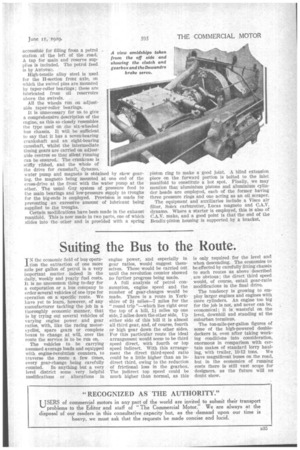Suiting the Bus to the Route.
Page 61

If you've noticed an error in this article please click here to report it so we can fix it.
IN the economic field of bus operation the extraction of one more mile per gallon of petrol is a very important matter indeed in the daily, weekly and yearly fuel costs. It is no uncommon thing to-day for a corporation or a bus company to order several vehicles of one type for operation on a specific route. We have yet to learn, however, of any manufacturer tackling the job in a thoroughly economic manner, that is by trying out several vehicles of varying engine power and gear ratios, with, like the racing motorcyclist, spare gears or complete boxes to change at will, over the route the service is to be run on.
• The vehicles to be carrying assumed average loads and equipped with engine-revolution counters, to traverse the route a few times, every gear-change being carefully counted. In anything but a very level district some very helpful modifications or alterations in engine power, and especially in gear ratios, would suggest themselves. These would be carried out until the revolution counter showed no further progress being made.
A full analysis of petrol consumption, engine speed and the number of gear-changes would be made. There is a route in Yorkshire of 3i miles-7 miles for the "round trip "—which lies right over
the top of a hill, miles up one side, 2 miles down the other side. Up either side of this hill it is almost all third gear, and, of course, fourth or high gear down the other sides. For this particular route the ideal arrangement would seem to be third speed direct, with fourth or top speed indirect. With this arrangement the direct third-speed ratio could be a little higher than an indirect third, owing to the reduction of frictional loss in the gearbox. The indirect top speed could be much higher than normal, as this
is only required for the level and when descending. The economies to be effected by carefully fitting chassis to such routes as above described , are obvious; the direct third speed would, of course, entail gear-ratio modifications in the final drive.
The tendency is growing to employ larger engines and engines with more cylinders. An engine too big for the job is not, and never can be, economical ; it is wasteful on the level, downhill and standing at the suburban terminus.
The ton-mile-per-gallon figures of some of the high-powered double-j deckers is, even after taking working conditions into consideration, enormous in comparison with certain makes of standard lorry haul ing, with trailer, 10-12 tons. We have magnificent buses on the road, but In the economics of running costs there is still vast scope for designers, as the future will no doubt show.




















































































































